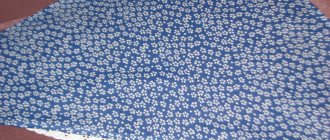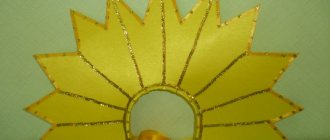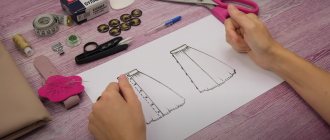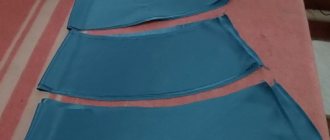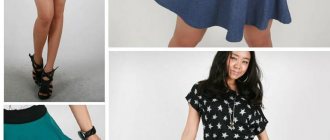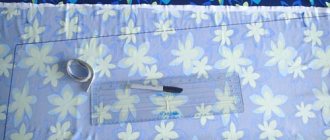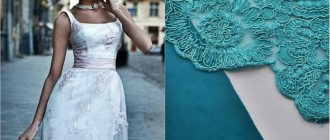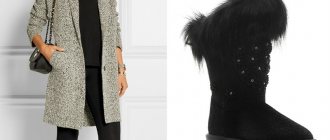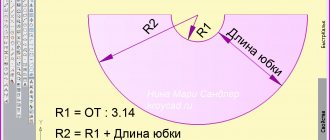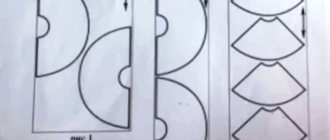Home / Question - answer
Back
Published: December 20, 2020
Reading time: 1 minute
2
424
A skirt made using pleated technology does not go out of fashion for a long time. Fabric with small, non-sharp folds appeared in Ancient Egypt. It was a decorative element that could be found on both women's and men's suits. The 20s of the last century – the fashion for cocktail dresses with fluttering hems.
Corrugated and pleated retain their original appearance for a long time. Both fabrics elongate the figure, and with the help of spectacular non-linear corrugation you can disguise weak points. Now you need to figure out how corrugation differs from pleated.
- 1 Wrinkling technology
- 2 What is the difference between corrugated and pleated
- 3 Application of folded materials
- 4 Conclusion
The difference between pleated and corrugated
Corrugating fabric has become a fashion trend since ancient times. Even the ancient Egyptians learned to emphasize the figure with the help of folds. At the same time, men also followed the fashion trend.
There are two common types of pleats: corrugated and pleated. The production technology for both is similar: they are formed by pressing, which can be done at home using an iron.
What does corrugation look like?
External corrugation and pleated difference lies in two details.
- Fold width.
- Placement of folds.
Strips of fabric in pleated fabric are located parallel to each other, while corrugated fabric is distinguished by a kind of “accordion”, because the folds lie at a slight angle.
Pleated fabric consists of folds of the same length and width, which creates a unique geometric effect. Corrugated, on the contrary, can be chaotic, leaving freedom of imagination to the designer. However, in order to purchase a beautiful thing, you don’t need to know the difference between corrugation and pleated.
Pleated fabric
Fashionistas appreciate the obvious advantages of ruffled clothing: it suits almost everyone, lengthens the legs, and makes the silhouette more elegant. Pleated fabric has only one disadvantage - it is difficult to care for.
Corrugated clothing
Where are folds used?
Corrugated and pleated fabric is a favorite tool not only for fashion designers, but also for interior designers in Stavropol. Folds are used when sewing the following items:
- skirts of different lengths;
- dresses;
- blouses;
- curtains and blinds.
Note! Pleating is especially relevant in the warm season. Light, airy materials make weightless dresses that visually lengthen legs due to straight lines formed by corrugation.
Ruffled skirt
If blinds have recently faded into the background, then the use of pleated curtains is only gaining momentum. This is not surprising if we remember the advantages of such curtains:
- Pleated curtains are often placed on attic and roof windows. By installing a remote control, the home owner can lower and raise the curtains at his discretion.
- Vertical and horizontal folds completely change the visual perception of rooms. Vertical ones make the room taller, and horizontal ones make the room more spacious.
- Corrugated curtains are easy to decorate inclined surfaces.
Pleated skirt
Pleated and corrugated designs are of interest not only to fashion connoisseurs, but also to those who are interested in interior design. Pleated fabric makes you look at things in a new way.
Model differences in length
The range of pleated and pleated skirts is wide, because this solution looks interesting regardless of the length of the product. There are four standard length options:
- maxi;
- midi;
- mid-length skirt;
- mini.
Ruffled dress
For any length, it is important to choose the appropriate type of fabric and color scheme. When buying a ruffled dress, take into account your body type.
So, a miniskirt will fit well on the owner of narrow hips and broad shoulders. Many people associate folds with school uniforms. Dense material is usually used for sewing. If the corrugated edge barely reaches the knee, we are talking about a medium length. There is a wider choice of fabrics here; airy chiffon and organza look good.
A similar variation in the types of fabrics is observed in midi-length skirts that reach the knees. Dense or weightless pleating will look equally good on a girl with a narrow waist and long, slender legs.
Many women decide to wear a conservative maxi, and for good reason - an outfit below the knee or to the floor will only emphasize the femininity of its owner. To create the longest hemlines, airy fabrics are often used: chiffon, taffeta, organza. Silk and crepe flow beautifully.
Pleated dress
Models and styles of ruffled skirts
A variety of shapes, styles and colors allows you to choose the ideal model that will adorn any woman, regardless of age and body shape. Stylists recommend that slender girls wear skirts, as such designs visually increase volume and add femininity. However, plump women should not exclude such an element of the ensemble. Wearing a skirt with a yoke is the best solution to add slimness to your waist and hips. This option is ideal for overweight women and allows you to visually correct your figure.
It is important to choose the right not only style, but also the length of the product. Among the many models, we can highlight long samples that suit absolutely everyone, regardless of shape and volume. Floor-length skirts add height and elegance to the silhouette. This element should be in every woman’s wardrobe, as it allows you to create stunning ensembles. You can also experiment with midi length or miniature skirts. A short ruffled skirt looks stylish and fashionable, suitable for those with slender legs. Such a thing always adds playfulness to the image, especially if it is made of airy and transparent fabrics.
If you want to add pomp and volume to your figure, it is better to use them, which are very easy to sew with your own hands. You can accentuate your waist with an elastic band or a tight belt, which will highlight your slim silhouette.
An attractive ruffled skirt with elastic is a universal model that provides freedom of movement, convenience and comfort. Such products are suitable for everyone without exception and can be of different lengths and colors. Plain patterns are a classic, so there are many fans of this style of clothing. Multi-colored skirts, polka dots, floral prints, and abstractions allow you to emphasize individuality, brightness and your own uniqueness. A long, plain ruffled skirt looks very stylish - black, white, mint, red, turquoise. An elastic band or belt in a contrasting color will highlight the product and add attractiveness to it. It is important to choose all the elements of the ensemble correctly, then you will be able to create a harmonious and original image.
What to wear with ruffles and pleats and how to do it
Under a pleated skirt in any girl’s closet there are a dozen options that can create a bright image.
Important! When choosing your top outfit, consider the time of year. A sports and very expensive T-shirt will be inappropriate in winter.
Winter version of corrugation
Designers give several recommendations to those who do not know what to combine with corrugation in any season.
- In winter - a fur coat or sheepskin coat. It is recommended to choose short fluffy coats. Add a pop of color to your look by wearing a large knitted scarf and gloves. Insulate your feet with boots.
- In autumn and spring, you should give preference to tops, turtlenecks and sweaters. Oversized models have long been in fashion, but if you want to emphasize your waist, feel free to use a belt and tight models. The look will be completed with high-heeled shoes.
- In the hot summer, choose not only skirts made of light fabrics, but also weightless blouses, T-shirts and tops.
A pleated skirt will be an excellent detail for a sport chic look, which is based on a combination of sports and glamorous clothing. The pleated look is ideally complemented by comfortable sneakers, a bomber jacket, and a leather jacket.
Sports pleated skirt
Larger girls need to think carefully before purchasing ruffled clothing. If a skillfully selected skirt hides the excess volume of the hips, for example, a blouse in the warehouse will only make the image heavier.
Make sure that the corrugation envelops the body freely, without forming tension. Otherwise, the playful fold will disappear, turning the outfit into a fashion designer's nightmare. Some stores offer models with pleated inserts that are located in strategic locations.
Corrugated product
Don't stop at skirts and dresses. A ruffled scarf or collar will add an interesting accent to your look. However, every detail of the outfit must be thought out.
What to wear with a pleated skirt
Spring, autumn
In spring or autumn, light skirts are best combined with a voluminous top. A wide shirt or a knitted short sweater is suitable for this. When wearing a pleated dress with a jacket or long jacket, you can maintain proportionality and at the same time emphasize the waist by using a thin belt. Pleated shirts will look no less impressive with a turtleneck or a tight top tucked under the belt.
In soft powdery tones
Pink and wine shades in skirt models
In blue tones
In summer
In summer, the ideal complement to a pleated skirt will be things made of transparent and airy material - blouses, T-shirts, tops. Various belts that are worn directly on a skirt or on outerwear are suitable as accessories.
With heels
Variety of models and variations
Beige
in winter
In winter, a pleated or ruffled skirt will look good with a fluffy or short fur coat. Wide belts and knitted scarves will help complement your winter look.
Variations of green shades in images
While creating an elegant look, remember that if the skirt has bright colors, a fashionable print, original embroidery and combines several different shades, then it is better to choose a plain top with a minimum amount of decor.
Using a pleated print
Making pleated pleats at home
If a fashionista doesn’t have a fashionable outfit in her closet, there’s nothing stopping you from making pleats with your own hands, how to make pleats? At home, the skirt will turn out no worse. There are many master classes on the Internet, but the basis of all lessons is the preparation of a paper template.
Pleated
Having cut a piece of fabric of the required size, we begin preparations. To make pleated pleats at home you will need the following:
- selected material;
- Whatman paper (you will need two sheets, the size of which depends on the size of the future product);
- ruler;
- pencil;
- iron;
- clamps;
- any heavy object.
The work begins with making a template. Whatman paper is folded like an accordion, the strips should be the same width, the size of the fold can be chosen as desired. But the narrower the stripes, the more interesting the result! The output is two accordions. To make geometrically even folds that will be identical to each other, mark the fold lines in advance with a pencil and ruler.
Corrugated image
Note! When choosing material for experiments, set aside silk, cotton and other 100% natural fabrics. To ensure that the formed folds keep their shape for a long time, it is recommended to use fabric with at least 50% artificial fiber content. After ironing, the synthetic material will bake on the fold line, strengthening it.
However, even natural fabric can be made pliable and obedient. For this purpose, the material is treated with special substances. After treatment, items can no longer be washed; you will have to use dry cleaning services.
Before the main preparations, you need to take into account that the production of pleated fabric will take triple the amount of fabric. In order not to be mistaken with the sizes, the hip volume obtained during measurement is multiplied by three, leaving a little space for the seams.
If you choose natural fabric, then it needs to be moistened with a special composition that can be prepared at home: 20 grams of soap (it is convenient to use shavings) and 2 tablespoons of vinegar diluted in three liters of water.
The fabric soaked in the solution is applied to whatman paper that has been previously unbent and laid out on the table, then covered with the same sheet of paper. To ensure that the resulting structure holds its shape, stationery clips are used. Whatman paper on the table surface is held under pressure.
Pleated look
After the material is securely fixed to the paper, it is steamed and ironed. After 8 hours, the fabric is taken out and clear, even folds are observed on it - pleated. If all steps are completed correctly, the material will hold its shape well.
Note! The template used to create the folds can be used repeatedly. However, wide folds, or, conversely, narrower ones, cannot be made with it.
Care for the resulting pleating must be taken with great care. When an item is purchased in a store, all you need to do to wash it properly is look at the label. It is better to entrust a home-made product to dry cleaning professionals. 100% synthetic items keep their shape perfectly, so they can be easily washed by hand without wringing. Should be washed in warm water.
As for the iron, it is almost impossible to iron pleated fabric. All that remains is to prevent your clothes from becoming wrinkled - hangers in the closet will help with this.
Pleated and ruffled have minor differences, but any of these design solutions will make the look feminine and modern. When choosing a dress or skirt made of pleated fabric, take into account your body type and pay attention to the quality of the fabric.
Detailed instructions for creating a pleated skirt:
- The first step is to measure the parameters. You need to measure your waist, hips and set the desired length of clothing. These parameters will help you calculate the required amount of fabric that will be used to sew the skirt.
- In order to find out the required amount of fabric, you need to multiply the hip circumference by three and add 4-5 centimeters for allowances.
- With chalk or soap, you need to mark two pieces at the desired length and add a couple of centimeters for the hem, as well as 2-3 centimeters for the allowances around the waist.
- Then you need to cut the fabric, the width of which is two lengths, in half, process it with an overlocker and bend it 2-3 centimeters, and then hem and iron it.
- Next, you need to make markings for making pleated fabrics at home, again using chalk or soap. To do this, you need to draw straight vertical lines at equal distances, starting from the side seam.
- After marking, you can start pleating. It is best to start from the middle so that the side seam does not come out. Folds must be fixed with needles or pins and after that they can be basted every 2 folds. You need to baste along the entire length of the line, and then iron the product. On the other side of the middle you need to perform the same operations.
Note! You need to iron the folds through a damp cloth and on both sides.
- Then the strips need to be aligned and the top edge is sewn using a regular stitch on the machine, leaving the hem unsewn. At the end, you need to sew up the hem and press the seam on it.
- After pleating, all that remains is to choose any belt at your discretion and sew it to the skirt.
- The last step is to get rid of the basting and iron the entire product again on both sides and through a damp cloth. The production of pleated fabric is completed.
Important! In order not to spoil the corrugation or pleated fabric, you need to properly care for it. The product can only be stored hanging on a hanger and washed by hand. After washing, under no circumstances should you wring out the fabric or iron it. Compliance with these conditions will help keep your clothes in their original condition for a longer time. If the fabric is made from natural materials, for example, linen, then the item should be entrusted to dry cleaners.
Pleated and corrugated products are a must-have in every woman's wardrobe. Such skirts and dresses are ideal for slender and thin girls, because they will be able to highlight their thin waist. For those with curvy figures, long maxi skirts are recommended to highlight the best features of their body type. With the right combination of things, the image always turns out luxurious and elegant. In this case, it will definitely not be possible to remain unnoticed.
Origin story
Folds in clothing design have a long history. They emphasize the curves of the body in a special way, form a silhouette line, and give models a unique charm. Ironed and stitched folds have long been used in men's and women's wardrobes. In ancient times they were status clothes - only noble rich people could afford such clothes.
The attire of nobles in Ancient Egypt was folded. Much evidence of this has survived to this day: drawings on amphorae, in tombs, etc. Similar outfits were worn by noble persons in Ancient Greece. Later, strict folds decorated the national clothes of many nations. For example, a Scottish kilt or a Japanese seifuku.
The concept of pleated appeared in France in the Middle Ages. The term is derived from the Greek “fold” and from the French “to wrinkle”. Corrugated in the fashion capital got its name thanks to the verb gaufrer. It is translated into Russian as “pressing folds.”
In the 50s of the last century, ruffles and pleated fabrics experienced a meteoric rise, leaving the fashion catwalks for casual style products.
What to sew from pleated fabrics?
A few years ago, long pleated skirts returned to mass fashion. They filled all the stores, regardless of the price segment, and then just as enormously bored everyone at once. How else can pleating and corrugated elements be represented in a product?
The first thing that comes to mind is a pleated insert in a dress or skirt with a laconic cut. Pleating individual parts (for example, sleeves or collar) of a silk blouse will allow an ordinary model to gain some zest. Pairing a sheer overskirt or dress over a matching dress or simple-cut skirt is another eye-catching solution for evening wear. Fine pleating of flowing ruffles can also add romance and playfulness to a flirtatious image with flounces.
Pleating looks most elegant on thin, flowy fabrics; it’s a great idea for creating an impressive look.
Manufacturing technology
The technology for producing gofre and plisse fabrics involves the final finishing of plain, twill or satin weave fabrics, thin or medium density. Cotton, linen, silk, wool and synthetic fabrics are suitable for this method.
- Stable bends on the material are obtained through mechanical or chemical cycles. The fabric goes into production after dyeing. The formation of bends occurs on special equipment - a folding mechanism.
- After the folds are formed, they are secured: using heated rollers with hot steam, high pressure, or mechanically (stitching folds).
The processes of corrugation and pleating are identical, and differ in the structure of the bends. The essence of the formation of folds using chemical reagents (pre-condensates of thermoactive resins) lies in the formation of folds and their fixation using wet-heat treatment or thermofixation.
Main differences
The methods for producing permanent folds on fabric on an industrial scale are no different. The question arises: what is the difference between corrugation and pleated. The secret lies in the “architecture” of the curves.
Pleats are parallel flat folds laid in one or two directions. Three types of forming straight bends:
- normal size - the visible part of the fold is equal in width to the invisible one;
- dense - the visible one overlaps the invisible one, has a large width;
- economical - the width of the invisible (lower part of the fold) exceeds the visible one.
Corrugation is a fabric on which folds form a relief ribbed surface. The difference from pleated is that the distance between the folds can be the same, or expand downwards.
Folds are distinguished by shape - rectilinear or arcuate, by design - continuous and group, and by size.
Application
Pleated and corrugated fabrics are used for sewing men's, women's, and children's clothing. Corrugated and pleated have differences in modeling. The casual, romantic first option is suitable for clothing and accessories for everyday wear and evening events.
Pleated fabrics are distinguished by their strict shape, which is why the material is used in sewing office clothes and school uniforms. In men's models it is used less often, as a rule, for designer decoration.
Both types of fabric are used in sewing linen items and for interior design. Folded materials are widely used in the production of silk and tulle curtains. Draperies are used in clothing and interior designs. The direction of folds in women's dresses and skirts can be varied using a non-standard cut.
Judging by numerous reviews from women, a pleated skirt is a necessary item of basic wardrobe. She looks great in a business suit and in a festive version.
What to wear with a ruffled skirt?
When putting together an ensemble, it is important to take into account every little detail and choose the right elements and accessories. It is better to use a less bright top, then the skirt will be a catchy and beautiful accent of the ensemble. A natural look can be achieved with elegant blouses, sweaters, tops or T-shirts tucked inside. What to wear with ruffled skirts is up to you to decide. Try on many options, combining products of different lengths with certain elements of the ensemble.
Long samples are in perfect harmony with shoes and elegant blouses. Products of medium length are combined with short jackets and flat shoes - ballet flats or slip-ons. Mini skirts can be paired with high-soled shoes or sandals, stilettos and a waist-length top. Tall girls can safely wear a skirt and shoes of any length. For short women, long or medium-length skirts and shoes are more preferable. This ensemble will add height and slenderness to your silhouette.
A favorite youth style is a combination of short items with tops or T-shirts. As for accessories, the choice depends on taste and fashion preferences. You can use stylish glasses, fashionable handbags - or slings, luxurious bracelets from or. Necklaces, beads, earrings can serve as jewelry, and a hat or gloves will highlight your individuality. A chiffon scarf or handkerchief effectively accentuates the style.
When composing an ensemble, you should combine elements and details, taking into account the texture, color and style of the products.
Today, pleated and ruffled skirts are in fashion, which women love for their airiness and geometricity. These wardrobe items elongate the legs and make their owner sexy and attractive - but is there any difference between them?
How to pleat fabric at home
You can crimp and pleat fabric at home. The difference is that in production this operation will be carried out faster, eliminating the possibility of errors. The process will take a long time.
- To form pleated folds, you will need to prepare a cardboard mold. If there is no ready-made one, they make one from sheets of thick Whatman paper, laid one on top of the other in 5 folds. Strictly parallel fold markings are made on the paper field.
- The fabric is moistened in the prepared solution: a crushed piece of laundry soap per 3 liters of water and 1 - 2 tbsp. l. vinegar. The material is applied to the lower mold, covered with the upper one and treated with the hottest steam possible for 3 - 5 hours.
- At home, use a steam generator. In specialized studios there is an autoclave. The fabrics must be completely dry after the steam procedure, after which the form can be removed.
Care instructions
Any types of corrugation and pleated require a delicate attitude. It is unacceptable to bleach, twist, or iron finished products. They need to be washed separately from other things. The folds are first sewn up with a thin needle using large stitches along the length.
The water temperature when washing should not exceed 40 degrees. The product is not wrung out. Dry in a vertical position. Store rolled up.
With proper care, a fashion item will not lose its attractiveness and will last a long time.
Pleated and corrugated: the difference is in the details
A skirt made using pleated technology does not go out of fashion for a long time.
Fabric with small, non-sharp folds appeared in Ancient Egypt. It was a decorative element that could be found on both women's and men's suits. The 20s of the last century - the fashion for cocktail dresses with fluttering hems. Corrugated and pleated retain their original appearance for a long time. Both fabrics elongate the figure, and with the help of spectacular non-linear corrugation you can disguise weak points. Now you need to figure out how corrugation differs from pleated.
Folds may be cracked
Crash (or crinkle) is a crinkled fabric with the now fashionable “forgot to iron” effect of wrinkles . Numerous original crash folds, creases, protrusions, wrinkles and other textured irregularities - for the most creative individuals!
crashed chiffon blouse
crash jeans
Leonidova, edited by Tsvet-ok
- < All about swimsuits for plump women
- What does style consist of? Style Components >
Crease technology
You can corrugate or obtain even folds using a certain technology. For this, paper forms are used that form a parallel or fan-shaped strip on the canvas. To obtain a clear shape, the arrows are treated with an iron.
To obtain a skirt in the ruffled and pleated style, Egyptian craftsmen coated the fabric with gelatin obtained from fish bones. Afterwards, the fabric was laid out on special boards with gutters. Scientists suggest that a hot metal rod was used to obtain the pleating.
Options for dresses with pleated or ruffled skirt
Usually in dresses only the skirt is pleated, and the top is made straight and smooth with beaded or lace trim. But in the latest collections you can see dresses with sleeves or bodice with fine pleating, which makes them romantic and airy. Some designers decided to make their dresses completely ruffled.
Dresses from fashion houses
In fashion collections
Dresses from world catwalks
High-waisted models made in the Empire style look especially picturesque. In general, corrugated and pleated fabrics are very easy to cut, so they are used to give items a stretch effect and hide possible figure flaws.
Dress elements
Typically they are used as follows:
At all times, the ruffled skirt has been in fashion - a particularly attractive part of the wardrobe, giving extraordinary charm and charm to a woman’s image. Despite its cuteness and tenderness, the skirt is practical, versatile and suitable for a wide variety of events. You can wear the product to a holiday, work, business meetings, friendly parties or to the movies. This bright element of a women's ensemble attracts attention and accentuates style. The exclusive advantage of corrugated samples is the ability to hide figure flaws and emphasize its advantages.
What is the difference between corrugated and pleated
The difference between corrugation and pleated may be unclear to the inexperienced eye. Pleating technology appeared in the ancient world; only the French were able to name pleated fabric in the 17th century. The width of the segment can vary from 5 mm to 5 cm. The fold can be bow or counter.
Advice: silk, taffeta, chiffon and other natural compositions should be dry cleaned; washing at home is only suitable for synthetic fabrics.
The folds are at an angle between each other, so the fabric visually looks like an accordion. The arrangement of the stripes does not lend itself to patterns, which makes them different from each other. Corrugated fabric, made using technology where the fold and hem are the same size, is considered standard. A fabric that has a stripe 0.5 cm wide at the waist and 2 cm wide at the bottom is called flared.
Pleated and corrugated are 2 different types of folds. The first one looks “lying down”, smoothed, and the second one looks voluminous.
Today there are vertical, diagonal, and horizontal stripes. The combination of different types in one outfit allows you to get a chic, airy look.
We cut and sew a pleated and ruffled skirt
If you purchased ready-made pleated or corrugated fabric in a store, please note that to sew a skirt you will need a piece of fabric of a standard width (150 cm) and a length approximately equal to the length of the future skirt (+5 cm for processing the top and bottom of the product). The skirt can be short, knee-length, or floor-length. Next we proceed according to the scheme:
- Measure your waist (the waist should fit fairly snug).
- Place the fabric on a flat surface and fold it in half.
- Depending on the length of the future skirt, add a seam allowance, leaving room for the waistband.
And then - we sew!
- Fold the fabric to the width of the waistband and sew along the edge.
- Process the bottom of the product with a double hem.
- Thread an elastic band into the hole for the belt and sew on both sides. To prevent the elastic from turning during wear and causing discomfort, stitch it in two places.
- Connect the side sections of the skirt, leaving 1 cm from the edge.
Application of folded materials
Lightweight pleated fabric allows you to hide unwanted pounds. The vertical stripe visually elongates the figure, making the silhouette slimmer and taller. It should be remembered that corrugated clothing adds volume.
Advice: for women with a curvy bottom, it is not advisable to give preference to knee-length skirts made using corrugated or pleated technology. The best option is a long skirt with a wide pleat.
The difference between pleated and corrugated is the width of the strip bend and direction. The latter option gives more opportunities for seamstresses - volume, differences along the entire length. The name pleated stands for the same “conveyor” strip.
A pleated skirt is a popular fashion look. The fabric can be used to sew an entire product or form part of an image. A silk blouse looks more impressive with pleated sleeves. Falling ruffles add romance to the items. In the photo you can see various options for business and evening outfits.
Author:
Anastasia Kukushkina
I hope you enjoy the article I have prepared for you! If you find errors in it, write to me about it! I will answer any questions you have, ask them! ????
The market offers a wide color palette, a variety of textures, including natural fabrics, for example, chiffon, wool. Pleated or corrugated polyester has gained popularity. The latter is used for tailoring and interior decoration.
Selection of materials
The ideal material for sewing ruffled skirts is light fabric - silk or chiffon. Airy patterns are very beautiful and add femininity, tenderness and lightness to the image. Every woman will feel younger and more attractive when wearing a pleated or ruffled skirt. Young people prefer products made from translucent fabrics that add sexuality and originality. Older women prefer knitwear that disguises figure imperfections and softens shapes.
At the peak of popularity there was and remains a knitted ruffled skirt that fits the figure to a certain extent. This is a practical, comfortable outfit suitable for spring, autumn and winter. Most often, monochromatic products are made that are in perfect harmony with other elements of the ensemble.
. The photo shows many options for different shades and design methods. Fashionistas can make knitted patterns with their own hands according to patterns, using various materials and accessories. Special methods of crocheting or knitting allow you to produce real masterpieces, luxurious products with a unique design and style. Small bows, elastic, lace or armholes are used as decorative elements.
No less relevant is a corrugated leather skirt, which has special properties. This is a soft, elastic thing that fits the silhouette and adds sexuality and charm to a woman's image. Available in black or light colors, sometimes with contrasting shades. These skirts are suitable for work, going to the cinema or theater, friendly meetings or parties. The ideal length for skirts is minimal or below the knee, since long leather samples look a little rough. The advantage of such a product is its versatility and practicality, the ability to accentuate style and decorate the silhouette.
